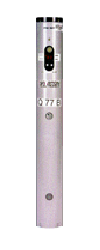


 The AN/SSQ-77B Vertical Line Array Directional Frequency Analysis and Recording (VLAD) sonobuoy is an A-size, expendable, non-repairable sonobuoy. The VLAD, a special purpose sonobuoy based on the AN/SSQ-53
sensor in conjunction with two arrays of eight omni hydrophones each, is designed to increase the detection of signals of interest in an environment where there is an ever-increasing amount of ambient noise. This increased detection capability is accomplished through the use of beamforming technology. Beamforming provides enhanced reception of desired threat signals of interest while attenuating reception of unwanted noise. This technology gives the monitoring unit(s) the ability to search, detect, and classify a target at extended ranges with minimum expenditure of sonobuoys.
The VLAD sonobuoy is an expendable, omnidirectional passive sonar unit. The VLAD uses a multi-element omnidirectional hydrophone array and a beamforming filter assembly
to enhance acoustic sensitivity. The VLAD has a selectable configuration incorporated into the EFS. This allows the operator to select either bottom bounce or convergence zone sound reception.
The AN/SSQ-77B Vertical Line Array Directional Frequency Analysis and Recording (VLAD) sonobuoy is an A-size, expendable, non-repairable sonobuoy. The VLAD, a special purpose sonobuoy based on the AN/SSQ-53
sensor in conjunction with two arrays of eight omni hydrophones each, is designed to increase the detection of signals of interest in an environment where there is an ever-increasing amount of ambient noise. This increased detection capability is accomplished through the use of beamforming technology. Beamforming provides enhanced reception of desired threat signals of interest while attenuating reception of unwanted noise. This technology gives the monitoring unit(s) the ability to search, detect, and classify a target at extended ranges with minimum expenditure of sonobuoys.
The VLAD sonobuoy is an expendable, omnidirectional passive sonar unit. The VLAD uses a multi-element omnidirectional hydrophone array and a beamforming filter assembly
to enhance acoustic sensitivity. The VLAD has a selectable configuration incorporated into the EFS. This allows the operator to select either bottom bounce or convergence zone sound reception.
In June 1980 the Navy granted Approval for Service Use (ASU) for two advanced sonobuoys. The AN/SSQ-62 Directional Command Active Sonobuoy System (DICASS) and the AN/SSQ-77 Vertical Line Array DIFAR(VLAD) represented the first major improvements in the sonobuoy field since the AN/SSQ-53 DIFAR was introduced in 1968. These sonobuoys reinforce their article's unique position as the vital link between the search aircraft and "enemy in liquid space". They provided a three-to-five fold improvement over existing active and passive airborne sensors.
The AN/SSQ-77A has the directional capabilities of the AN/SSQ-53B DIFAR with the omni replaced with a vertical line array of omnidirectional hydrophones for improved tracking capability in a noisy, high-traffic environment. The main lobe of the vertical line array beam pattern can be steered for further improvement in signal to noise. Distant signals are enhanced with the Convergence Zone (CZ) beam pattern. The EFS will also allow selection of one of 99 RF channels, two operating depths of 500 and 1000 feet, and selectable life settings of one, four, or eight hours. In all other respects, the VLAD is comparable to the DIFAR.
The AN/SSQ-77B is an improved version of the AN/SSQ-77A, with three 3 different operating life selections (1, 4 or 8 hours) and dual (classified) depths. Additional signal enhancement is provided by processing the Bottom Bounce (BB) beam pattern. Either of two vertical line array beam patterns may be EFS selected for signal to noise optimization. The VLAD, upon self-activation, operates in a passive mode for the preset life, depth, and sound reception pattern. Upon reception of acoustic signals, the subsurface unit converts the pressure waves to amplified electronic signals. These signals are then transferred to the beamforming assembly where the signal is amplified and filtered and a magnetic bearing reference is applied. The amplified signal is then routed through the cable assembly to the surface unit and applied to an FM carrier for VHF transmission. The monitoring platform receives the signal for recording, processing, and analysis.